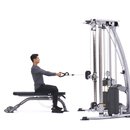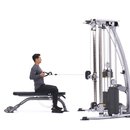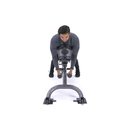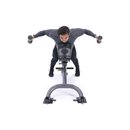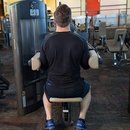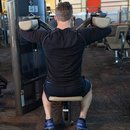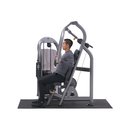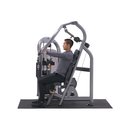The split system of training, in general, has been around almost as long as bodybuilding itself. Nonetheless, most beginners train, or at least are taught to train on a full body routine three times a week, usually M-W-F. This may be ok for learning the exercises and developing an initial foundation, but it has real flaws as far as promoting muscle gains. Why?
Because as you gain experience and begin to train with greater levels of intensity, you find the workload of a full body routine will become overwhelming.
In other words, you just can't train every body part with real intensity and a meaningful number of sets. This is where a split workout routine come in. This is also where it may become complicated, depending on your personal circumstances. And further, this is where, historically, any thought of recovery gets tossed in favor of all the latest six day a week routines printed up in the magazines.
Things To Consider
How's Your Schedule?
Before I detail several of the split routine options out there (there are a lot), you have to figure out what days you have available for training.
This probably will be the deciding factor in what you do - if, like me, you work full time and have lots of obligations, your days are limited.
You may find you only have two to three days available to train. However, a lot of young guys have anytime they want, so if your schedule permits, you can use virtually any type of split.
Recovery Time?
You also have to think about how much recovery time you will have. Remember, you grow in between workouts, when you are recovering, not because of how many workouts you do.
Read that last sentence about five times because in the 25 years I've been in bodybuilding, I still see far to many people that do not understand the concept of recovery.
Have You Recovered?
How recovered you are should determine when you should train. Different muscles recover at different rates than others, and any time you train two or more days in a row, you may be "resting" certain muscles while you train others but you are taxing your entire system, putting a drain on total recovery.
There are two ways to tell if you have recovered:
- If the body part you last trained is still sore on your next scheduled training day for that body part, you have not recovered.
- If you are unusually tired in the morning on any scheduled training day, and you haven't changed anything in you approach, you're probably entering an overtrained state - you aren't allowing enough time for recovery.
Different Affects On Recovery
Of course, recovery is different for different people:
- Age
- How genetically gifted you are
- Whether or not or are "chemically enhanced"
- Your eating habits
- Your job
- How hard you train
- Your set totals
All these things affect how fast you recover. Learn to tailor your workouts to your recovery ability.
Honestly, if more lifters did just that one simple thing, trained hard on a moderate number of sets and paid better attention to their nutrition, the rate of progress would skyrocket.
Types Of Splits
Of course, types of split routines and muscle groupings are almost endless:
2 Day
Body Split In Half: Lower Body On Day 1, Upper On Day 2.
This, to my mind, does not make much sense despite the fact it's a common split. The problem here is on day 1, you do legs. On day 2, you have to do everything else - that's back, chest, deltoids, triceps and biceps.
Don't forgot to include trap, forearm and ab work! So, how can you possibly train all these muscles with enough intensity to generate growth? You can't! Of course, you can change the body part groupings and do less sets and see some results.
Here's an example:
- Day 1: Legs, back, biceps, forearms, abs
- Day 2: Chest, deltoids, triceps, abs
This type of routine usually revolves around basic exercises. It's usually performed over 4 days - Mon/Thurs for workout 1 and Tues/Fri for workout 2, allowing 3 days of recovery. Of course, you can do it however you like, taking days off anywhere in the split as needed. Those of you who read my stuff know I don't always stick to a 7 day workout week, if need be, I go to a 8 or 9 day workout week.
Also, a routine of this type - with each workout done once a week - is often suggested as a great hard gainer routine because of the recovery time. Limit the sets, perhaps do no direct arm work ( eliminate arms from the above and you can see you have a much simpler routine) or a low set total for arms and work the basics hard.
3 Day
Push/Pull Routine
- Day 1: Legs, abs
- Day 2: Chest, deltoids, triceps, abs
- Day 3: Back, biceps, forearms, abs.
This is a very common split routine - it makes a lot of sense as well.
- Day 1, you do legs by themselves, which, if you squat (and you should) makes sense since leg work, done properly, is so grueling.
- Day 2, you do the pushing muscles - this makes sense as deltoids and triceps are involved in all chest exercises and triceps are involved in all deltoid exercises.
- Day 3 is pull day - this makes sense as biceps and forearms are involved in all back exercises. While some people do this complete split twice in one week ( 3 on/1 off), for many of us, once a week makes more sense.
This can be done on a rotating schedule where you always allow 2 days between each workout or on a set schedule where you train on pre determined days every week, such as Sunday, Wednesday and Friday.
Yet even this routine can pose problems - you may be to tired to give deltoids, triceps, biceps and forearms any real intensity.
4 Day Split
This routine allows further dividing of body parts than the push/pull split listed above:
- Day 1: Legs, abs,
- Day 2: Chest, triceps, abs
- Day 3: Back, biceps, forearms
- Day 4: Deltoids, abs
This allows you to group a smaller body part with a larger one, or just train some of the bigger areas alone, this way you can train all muscles with more intensity. While some advanced bodybuilders will do this a 4 on/ 1 off (1 day off out of 5) routine, you can squeeze in recovery days any way you like to or need to. As if you can't guess, I would definitely add more rest days to this.
The One Body Part Per Workout Split
You can set up rest days any way you want. Many people who use this use it as an "every other day "split or will even train 6-7 days in a row. You can divide up muscles any way you like, including sub-dividing: back into upper, lower and lats, deltoids into front, middle and rear, etc.
This is not a very popular split but may be good for pre-contest and/or for someone with a lot of time.
Here’s an example of a shoulder workout that balances work for all three heads:
The 6 Day Split
Arnold's split routine, really a 3 day split done twice in one week, with only one rest day.
The Double Split
This is actually Arnold's pre-contest routine: twice a day workouts, 6 days a week.
The Triple Split
An even more advanced pre contest routine where you train 3 times a day, usually a big body part such as legs in the morning, maybe cardio in the afternoon and a small area like abs at night, usually including posing practice at that time as well.
Conclusion
As you can see, there are a lot of choices. Many of these are advanced and are meant for people with a lot of time . The 3 day push/pull routine typically can meet most bodybuilders needs. I favor this one myself although I have used a 4 day split set up to train deltoids ( as listed above) on their own day.
I set this up over 8-9 days to allow for good recovery. This also allows extra work on weak body parts, and allows you to train for complete development. I don't use it now because my schedule has changed and it is no longer practical.
The most important thing to remember in using any split routine is to set it up to give you good recovery. Do that, eat good and train hard, which will force you to keep your set totals reasonable, and you'll make progress.


